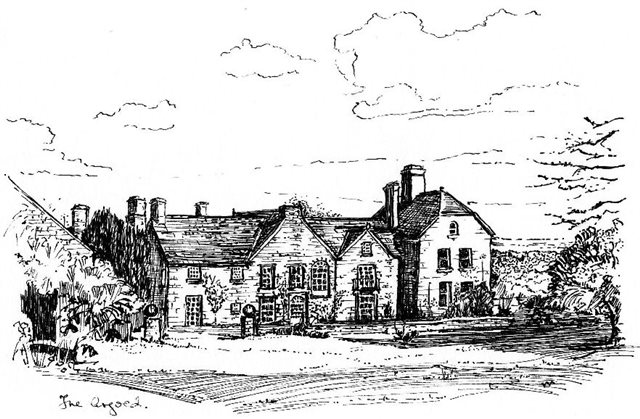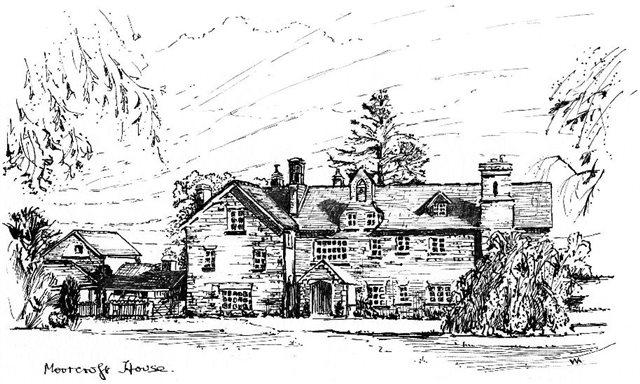Probably the oldest house in the parish is The Glyn, a roomy old farmhouse whose history is somewhat difficult to check; its barn has an ecclesiastical look, and what could have once been a priest’s hole has been found between floors. Horses were once shod in what is now the kitchen. It has been well cared for and loved by the families occupying it over the years.
But The Argoed, farmed in the 16th century by the Probert family and surviving wars and destruction, is the most important house in the village. Major Probert’s own account of its history appears elsewhere in this book. Its life was rekindled first by the Potters, followed by the Chatfields and then the younger branch of the original Probert family, all greatly contributing to its regeneration and, with benefactions and gifts to the church and village also. In the 1970’s it passed into the hands of the Sanger family, who modernised it. Blackcurrants were planted and the estate was divided into two, with the Coach House also being made into a home. Robert Plant, the Argoed’s present owner, carries on the tradition of conservation amid the quiet beauty of its setting described in a letter from George Bernard Shaw and quoted in Major Probert’s article on the history of the Argoed.

Moorcroft, another house whose early history we can trace, was built in 1748 and stands on the site of a small tenement called ‘Cae-pwll-du’ (‘the field of the black pit’). Was this the pit where the Black Death victims were buried? It was sold in 1809 to George Evans, an inn-keeper, who left the property to his daughter, Sarah Hatton. In 1838 the property was sold to Thomas Dyke for £650 and then to James Howell of Wandsworth, who in turn sold it ten years later to Rev William Bagnall Oakeley, who was for many years curate of Penallt. He changed the name of the house to Snakescroft, the name of his birthplace.

This is when we first hear tales of what we now know as Moorcroft, the name given to the house when bought by the Hon Arthur Lowther Pelham in 1883. The old cottage had been demolished by Rev Oakeley and the property rebuilt. Both the Pelhams (the cricketing family) and Rev Oakeley were benefactors to the church and village. Moorcroft was sold in 1921 to the author J del Sandys, and its place in our continuing parish history is assured with its present owners, Mr and Mrs R Hartley, who have in recent years offered its beautiful garden as the setting for annual church fete. Looking at it on a ‘fete’ day, it was interesting to see the old bell still in its setting high above the front door. An old resident remembers this being used to call in the field workers.
Another house of importance is Ty Mawr – originally part of the Argoed estate. It was once owned by the Hankey family, who were great church supporters and had their own private chapel in the house, an interesting prelude to the occupation of the house by the Society of the Sacred Cross, who subsequently built on their own lovely chapel. Although an enclosed order, they ‘give out’ much to the Parish, and the peace of the house and grounds, together with the adjacent Michaelgarth retreat house, has given a sense of tranquillity to visitors from all over the world.
Llananant is also a house of much interest – one near the older settlement of Penallt in the neighbourhood of the Parish church, from which it is said a secret passage runs. (It must have been very difficult to excavate this rocky terrain.) It was explored for a few yards at the turn of the century but a roof fall stopped progress … could it have been anything to do with the secret practice of the old rite? The house is situated in a sort of secret valley at right angles to the road from the Old Church. The walls of a once productive, sheltered walled garden still stand, and a small lake gathers the somewhat excessive waters of the neighbourhood. It is nowadays home to the Haeffner family who bought it after Mr and Mrs Leslie Spencer moved to a new house built on part of the land; this is unfortunately a little further away from the Old Church, where Mr Spencer’s help with the heating arrangements has been much appreciated!
Nearby is The Brook – home of Lt Col Evill and his family – part of which dates back to the 16th century and whose vegetable garden has yielded a collection of 17th century pottery shards.

Much of the other property within our seven square miles of parish was at one time owned by the Beaufort family – the deeds of Church Cottage give the rent as one shilling a year. This had originally been a cider house, besides at one time housing the curate. It is also said that the separate back floor top entrance was used to lead to a large upstairs room where indoor bowls was played. Church Farm was also a Beaufort property until 1902. It is beautifully situated above the Wye, but with sloping fields which must be difficult to work. The remains of the tithe barn are no longer within the farm land. (Tithes were legally abolished in 1936, but it was a long time before they were all cleared in Penallt.)
The Generals mill dates from the 13th century. The original cottage is detached from the present house which apparently was built by a General who, whilst staying at the Argoed, thought what a marvellous position to have a house; but on going ahead and building it, he found his wife didn’t like it. Alternatively, a different story relates that the General had got an Argoed maid ‘into trouble’ and built the house for her. In its mill-time days the corn came by river and was brought up to the mill by donkeys. For many years The Generals was owned by the du Heaume family.
In Penallt one farm is just called ‘The Farm’ and cottage names are interesting too. We don’t seem to bother in this district as to how many ‘Walnut Trees’, ‘Yew Trees’ or ‘Cherry Orchards’ we have! (Cherries used to be grown in many of the gardens of the parish, and wood from the many walnut trees was often sent to Birmingham to be used for gun butts.)
Cottages also get called after their owners, or sometimes owners after cottages! We had Mr Jackstone (ex Jackson) of ‘Jackstones’; Mr Robbins of ‘Robin’s Nest’ (he was celebrated for walking across the Wye); there is also ‘Grace’s Cottage’ and ‘Jessie’s Patch’, and it was a non-biblical Jacob (Evans) who lived up ‘Jacob’s Ladder’!
In the lower Lone Lane, Birches and Washings area (so called, we gather, because of the many springs ‘washing’ down to the Wye) there are many ruined cottages, situated in fields with daffodil ‘breaks’. They had their own wells and beehive-like stone bread ovens, and often housed at least six children (not in the ovens!). The ruins of a little school-house can be seen above Cuckham’s Pitch and what could have been quarry-workers’ houses or sheds to the west of Lone Lane.
This area of the parish remains relatively unchanged, but in the middle village area we are in the midst of a period of new house building. Old inhabitants remember this area as consisting of the School, with St Mary’s, the old Vicarage and four or five cottages, all surrounded by green fields, with sheep grazing. Lovely and quiet and peaceful, they say … no tractors! The Vicar in his letter of September 1988 wrote:
“Our latest wave of settlers are the refugees from traffic noise, who build spacious houses where planning permission allows, or convert old barns and cottages. House prices are already moving to South Eastern heights, squeezing first time buyers to less favoured districts. One notes these things, not objecting to change, but praying for the right grace peacefully to co-exist …”
[from: Penallt – A Village Miscellany]